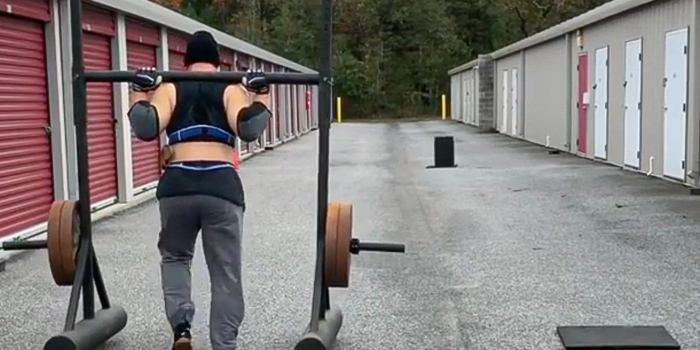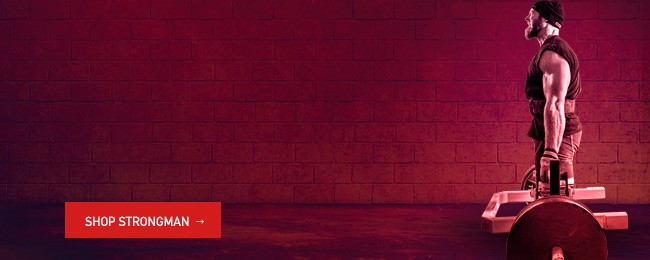
It’s looking like 2020 is shaping up to be the year of the garage gym. However, some people may not have room in their garage due to using it as a shop, for Christmas decoration storage, or from a desire to have their vehicle inside their house with them. For that matter, some people may not even have a garage at all. That makes it hard to set up a garage gym, so what do you do? The solution is simple: rent a garage, or in this case, a storage unit.
I have been training out of a storage unit for ten years now. Mostly just once a week on Saturday morning to do strongman event training, but I did have my old rack and platform in the unit for several months when I first moved back to Salisbury before my wife and I bought our house. Storage units make for excellent workout facilities, but there are several things to consider when choosing one.
RECENT: Lee Zimmerman's Home Gym Stays Open!
Location
How far is the unit from your home, work, etc.? Storage facilities are relatively common, and you want it to be convenient in terms of travel time to maximize ease of use and adherence to your workout plan.
Size and Cost
You can get storage units from very small 5’x5’ (think large pantry or front hall closet) if you just need a place to stick equipment, to very large 20’x20’ or bigger (think two-car garage) if you want to put in a platform and a rack and have lots of room for activities. When I was doing all my training inside the unit, I had a 15’x20’ unit. Other than that for storage of my strongman equipment and the ability to train atlas stones, deadlift, and OHP inside I have always had 10’x15’. Note: I usually do not train DL or OHP inside, but I have the space to do it if needed. I do train stones inside about half the time. The cost will vary with size, but lots of places offer discounts for students, AAA members, military, and law enforcement. There may be additional discounts for signing up for a full year, paying via recurrent electronic payments, etc.
Terrain
This is only applicable if you will be training outside of the unit, but look at the slope of the lanes between the rows of storage units. Is it flat or is there a grade? How much slant is there for water runoff? Is it paved or gravel? Don’t hesitate to ask to walk the property to see which lanes are the flattest if you plan to train outside of the unit, because that makes a huge difference for performing any exercise as well as for setup. Ask yourself, "Will a loaded bar or farmer’s handle roll away or stay in place?" I have always chosen businesses with paved lanes and requested to have a unit on the row or section of the row with the least slope to the pavement.
Amenities
Things like security gates, 24-hour access, floodlights for when it’s dark out, climate control, outdoor outlets, public restrooms, and others would fall into this category. Security gates are pretty standard, and most allow 24-hour access, but there are always exceptions, so be sure to check before signing a lease. Be careful with climate control. If it’s outdoors and climate-controlled, that probably just means the barest temp control and some humidity control. Temp range would probably be between 40 and 80 degrees, so still plenty hot and cold by most people’s standards. The humidity control will help keep the plates from rusting, though, which happens in non-climate controlled units depending on where you live. The facilities where the whole place is indoors would have better climate control, but probably also much less tolerance for using it to work out. I doubt you’d be able to do more than some bodyweight and suspension trainer stuff in one of those, but I have never tried. If you are planning on working out in partial or total darkness, lights become pretty important. Either permanent floodlights or an outdoor plug for something portable. I had also used a small portable power source to power a light and a fan as needed when I trained inside the unit. I would have to plug in the power source at home to recharge it for subsequent use. Now that we have covered how to select what storage unit is right for you, let’s cover some basic behavioral ground rules. I would think most of this should go without saying, but there are always some people whose level of asshole exceeds their level of common sense.
Don’t Be An Asshole
This covers things like swearing and playing offensive music when people are around. Most patrons of storage facilities are there for a few minutes to drop something off or pick something up, and then they are gone. When no one is around, no one cares. But the quickest way to lose your new garage gym away from home will be to have people complain about you to management. Even if they make stupid comments about “Why would you do that?” or how “You’re going to hurt yourself lifting weights,” try to restrain yourself from educating them on how wrong they are or why they might benefit from less talking and more lifting. In ten years across four different storage units, I have never had any of the places have any problems with me. Some even think it’s pretty cool.
Move When Needed
If you are blocking the lane with equipment, move it to the side so cars can get by if they pull into the lane. Most of them will back out and turn around if they don’t need to get to a unit on the same row as you or come in from the other direction. This goes along with the prior guideline about not pissing people off and having them complain about you. You may also need to move your vehicle sometimes if you park in front of a unit that someone needs access to, so be prepared to move that as well.
Help If Possible
Sure, you are there to work out, but sometimes people may ask you to help move something. I try to avoid long term commitments to help them load or unload a truck, but if they just need help moving one or two things which are heavy or awkward, I am usually perfectly willing to help out for five or ten minutes. Again, most people will bring help with them or be able to move their stuff, but if someone goes to the trouble to ask, they most likely need some help. Plus, it gets them out of the way and on their way sooner so you can get back to working out uninterrupted. Think of it as GPP.
Don’t Break Stuff
Here again, I would think this would be obvious, but I’ve seen people do some really stupid things. If you are dropping things or doing something like snatch or clean and jerk, use bumper plates with mats under your weights to protect the floor of the unit, the ground outside, or whatever else needs protecting. You will be liable for paying for damages you cause, and most places have security cameras everywhere now. So even though no one may be around, you’re still being recorded.
Finally, what should you put in your new garage gym away from home? Whatever equipment you will need for your workouts such as bars, plates, bumper plates, dumbbells, kettlebells, maybe a rack and platform, strongman implements. What else? Here is a quick list of stuff that might be less obvious or give you more options for workouts:
- Collars: Especially adjustable collars like Prolocs if you will be using any specialty bars or strongman equipment with substandard ends.
- Sledgehammer and Tire: Great for conditioning. Cheap and easy to procure.
- Sled, Prowler®, etc.: Storage units are great for conditioning work or sled work for strengthening (assuming it isn’t gravel).
- Blast Straps: Goes along with the sled and also obviously useful for performing tons of different upper, lower, and core exercises as well. Just be sure you have something to anchor it to if not using for sled work.
- Bands: For warmups, stretching, exercises, etc.
- Stall Mats: Either big ones or smaller squares, depending on your needs.
- Heavy-Duty Shelves or Pallet Rack: I have a pallet rack (i.e. hardware store/warehouse shelving) that I use for an adjustable height atlas stone platform. It also doubles as storage, anchor point for bands, blast straps, etc.
- Cones: Or something similar to mark off distance for sled pushes, farmers walks, yoke walks, zercher carries, you name it.
- Measurement Wheel: Could also use a long track-style tape measure, but the wheel is quicker and easier and can also serve as a distance marker itself.
- Light Source: Battery-powered or otherwise if training inside a dark storage unit or when it is dark out.
- Foam Roller: Or lax ball, PVC roller, acumobility ball, whatever your choice of soft tissue tool may be.
This list is far from comprehensive, but it would depend on what type of unit you get, what you plan to use it for, when you plan to use it, etc. I am definitely not the first or only person to train out of a storage unit. I originally got the idea from seeing HW pro strongman Travis Ortmayer doing it and have since seen a good number of other strongman/strongwoman athletes doing it as well all across the country. I’ve also never heard of anyone getting kicked out of a storage unit who used it for training or workouts. Not to say it hasn’t happened, but I’ve never heard of it. I did have one place tell me they had a band that used to use a storage unit for practice, but they got kicked out for people complaining about smoking and drinking during their band practice.
Conversely, I know a few people who have kept their drum kits in a storage unit and used it for practice without any problems, probably because they weren’t making a mess and having people complain about their extracurriculars. One final thing, I recommend not calling around and asking if it’s okay to workout in a storage unit. I did that the first time when I was looking for a unit 10 years ago and was universally turned down. If the place I want to rent asks me about it upfront when I am doing the paperwork, I always tell them because there is no point in lying about something they will definitely find out about, but there is also no reason to cause undue worry about what you’re going to do if it’s not needed. I hope this helps some of the people who have been put out of their gyms for the foreseeable future to at least get by and maintain if not flourish under the current restrictions we are living with.










